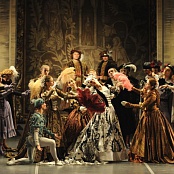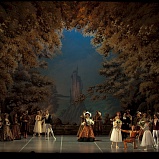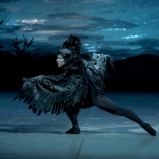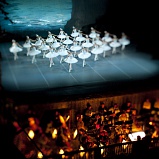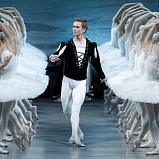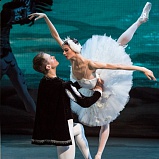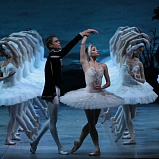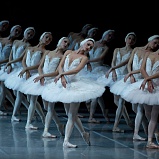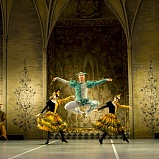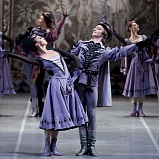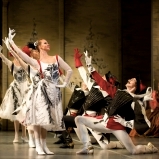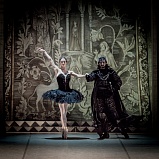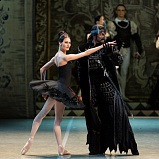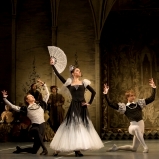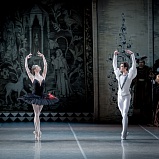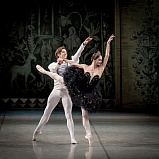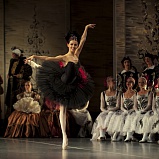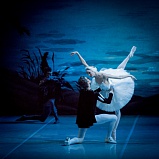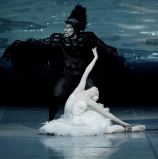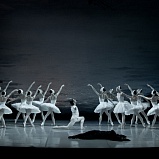- Credits
-
Staging based on the libretto by Vladimir Begichev and Vasily Geltser
Choreography by Marius Petipa, Lev Ivanov, Alexander Gorsky, and Asaf Messerer revised by Mikhail Messerer
Stage and Costume Design: Simon Virsaladze
Staging by Mikhail Messerer
Principal Designer of the revival: Vyacheslav Okunev
Revival Designer (maquette): Boris Kaminsky
Lighting Designer: Damir Ismagilov
Répétiteur, character dances: Alla Boguslavskaya
Ballet Master’s Assistants: Zhanna Ayupova, Irina Ivanova, Evgeny Popov, Natalia Tsyplakova
Répétiteurs: Evgeny Popov, Svetalana Efremova, Tatiana Legat, Elvira Khabibullina, Natalia Tsyplakova, Mikhail Sivakov
Costume Designers: Anna Kotlova, Larisa Ivushkina, Irina Talova, and Valentina Latukhina
Sets and costumes produced at the Vozrozhdenie Theatrical Design Studios
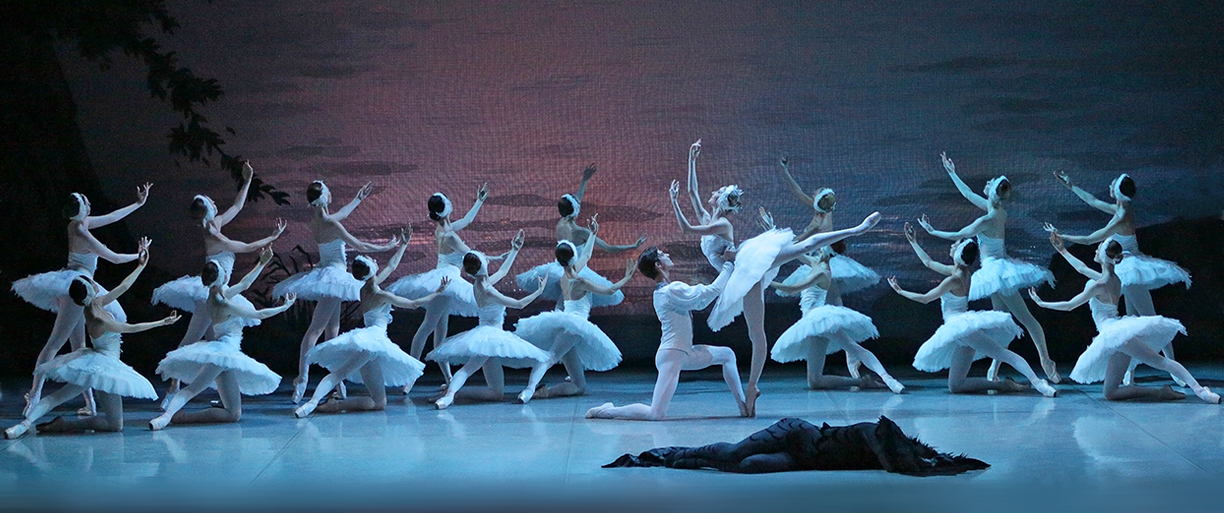
Premiere at the Mikhailovsky Theatre: 15 September 2009
Swan Lake is the ballet which embodies the soul of Russian art. The combination of brilliant music and choreography creates a special kind of magic; what the great 20th century choreographer George Balanchine had in mind when he famously said, “One should call every ballet Swan Lake because then people would come.”The Mikhailovsky Theatre offers a unique version of the ballet, which today cannot be seen anywhere else. A re-creation of the Bolshoi Theatre’s original production which was Soviet ballet’s claim to international fame for many years, the Mikhailovsky Theatre’s Swan Lake has also already received considerable critical acclaim. Reviews from around the world have called the performance “bright and flowing”, “respectful to every detail”, and have noted the work’s “inexplicable charm”, the elegance of the choreography, and the “tension, emotional fluctuations, and uniqueness of every swan in the apparently uniform flock.” But you do not need to be a seasoned ballet connoisseur to appreciate the subtle nuances of this production. Swan Lake is, first and foremost, a ballet for the heart.
The garden of the Sovereign Princess’s castle. While the young people disport themselves on the lawn, the jester amuses the guests with his antics and girls dance with their companions. The Princess informs her son Siegfried that at tomorrow’s ball he is to choose a fiancée from among the girls invited to the castle. Siegfried’s heart remains closed to her words, as he hasn’t yet known love. Night falls. The young people depart. Siegfried is overcome by conflicting emotions: he regrets the end of his freewheeling life while, at the same time, dreams of a pure, ideal lov e. But where is this girl to be found? Siegfried is bored by the conversation with his friends. A flock of swans catches Siegfried’s attention and he follows them.
Act II
The swans lead Siegfried to a lake, deep in a dark and wild wood. At the lake, the swans dance in a fairy circle. Siegfried catches sight of a beautiful swan which then turns into a girl. This is Odette, the Queen of Swans. The Evil Genius has placed her and her friends under a spell: the swan maidens can now become girls only at night. Only the love of a young man who has never promised himself to a woman can release them from the spell. Siegfried, full of love for Odette, swears that he will love her and be faithful to her forever. The Evil G enius overhears Siegfried and Odette’s conversation.
Daybreak. The girls turn back into swans. Siegfried, convinced of his feelings, will save Odette from the Evil Genius.
Act III
The ball at the Sovereign Princess’ castle at which Siegfried is to select his fiancée. The guests arrive at the party but Siegfried is nowhere to be seen. The jester begins his amusing dances and the guests start dancing too. Siegfried appears, yet he treats the prospective fiancées icily: he’s thinking only of the beautiful Odette.
A stranger arrives at the ball. It is the Evil Genius in disguise. He has brought his daughter Odile with him; she is strikingly reminiscent of Odette. The Evil Genius tells her to enchant Siegfried and make him swear eter nal love. The Prince doesn’t recognize the Evil Genius and mistakes Odile for Odette. He declares Odile as his chosen bride. The Evil Genius is triumphant: Siegfried’s vow to Odette has been broken and, as a result, she will die. He points to an image of Odette that appears in the distance and departs with Odile. Siegfried realizes that he has been deceived and rushes in despair to the lake.
Act IV
An ominous night at the lake. A despondent Odette reveals the tragic news about the broken vow. The swan maidens grieve: their hope of freedom is lost. Siegfried appears. He hasn’t broken his promise: it was his Odette, not Odile, who he saw at the castle. It was to her that he swore his undying love.
The outraged Evil Genius summons a storm against the lovers, lightning flashes. But nothing can overcome the pure love of inseparable Siegfried and Odette. The Evil Genius decides to fight Siegfried himself and dies in the clash. His spells are destroyed. Odette and Siegfried, surrounded by Odette’s friends, watch the sun rise.
Tatyana Kuznetsova, "Kommersant":
... Women corps de ballet has become the central figure of the new production, and the "swan" scenes appeared to be the main breakthrough. Agile, nervous and asymmetrical pattern of Gorsky- Messerer's compositions represented an astonishing contrast with conventional lines of harsh women in ballet tutus, lined up on ground with "goose" above their head (the pose with almost straightened elbow and turned off hand, just like a swan beak, which was created by Agrippina Vaganova). During Adagio of Odette her friends are not standing as if they were made of stone, just like the ministers of our government do on a keynote speech of prime minister. Instead of this they enter into details of the fateful love affair with typically women's curiosity: they move their legs in pas de bourr—e, sigh arabesques, shamefacedly turn aside, hiding their head beneath delicately rounded hand. Such activity of the corps added a charming vividness and warmth to the "lake" scenes. And we can only guess on the amount of efforts it took from Mikhail Messerer to show this kind of women immediateness.
Actually, the entire ballet — harmonious, logical, and dynamic — looks surprisingly cheerful and young for its age. Nothing needless, superfluous or pretentious: skilful stage direction leads action at ease to the optimistic final. And meltingly archaic writhes of the Evil Genius on the forestage only add a grain of irony to the unsophisticated triumph of good over evil. Gorsky's outstanding dances don't lose fabulous magnificence even with its imperfect performance, that's why student's constraint seems to be fully surmountable barrier. Indeed, the main thing is already done: the remarkable ballet is reincarnated, while it is the business of the adopting parents to bring it up and to improve it.
Olga Fedorchenko, "Kommersant-SPB":
... Mikhailovsky's Swan Lake of two Messerers — Alexander Gorsky — Lev Ivanov — is a solid, honestly made traditional ballet in the best sense of the term. The setting by Simon Virsaladze (reconstruction of decorations and dresses by Vyacheslav Okunev) brings us back to the golden age of the native ballet. In the first scene the "realistic" waltz is danced on heels, what highlights extra evanescence of the fantastic episodes on the lake. In the Act One Alexander Gorsky gave Siegfried objectively complex variation oriented on endless technical possibilities of young Asaf Messerer.
... "Swan" scenes chronologically and for a variety of marks are so much closer to the original work of 1895, than "patented" archetype of Mariinsky theatre. The arms and hands of the dancers are rounded according to the canon of 19th century, which provides choreography with special charm and softness. The style of Gorsky is seen in modifications in geography of composition: swans don't line up straight (so the famous "corridor", traditionally formed by two columns of swans, is missing). They form fanciful groups, contradicting the law of symmetry instead. So, if in the right part of the scene five dancers closed the circle then in the left one threesome kneeled down and behind them six dancers lined up in picturesque pose. Art-deco style is also maintained in group compositions: they are full of inexplicable attraction. The head is moved a little bit different, the body is inclined differently, the hands "sing" in a different way. These smooth "vegetative" movements revive an ancient comprehension of gracefulness and "velvety feeling", the term which was used frequently by the balletomanes of the past. Three Big Swans are dancing instead of the traditional foursome and there are four signets as yet, though Mr. Messerer apparently promises to bring this number up to six (as it was in the last Gorsky version).
Acrobatic elements were wisely taken away from the famous "white" Adagio. A shoulder lift became a substitute for caring over the dancer with her legs widely spread, which is not so aesthetically beautiful.
Anna Gordeeva, "Vremya Novostei":
... Petersburg's Mikhailovsky theatre opened the season with the premiere of Swan Lake by Alexander Gorsky — Asaf Messerer and this performance is one of the most vivid shows that fell to your ballet reviewer's lot in the last decade.
... It's been a long time since you can't watch this performance in Moscow, as it was replaced in 1968 by the gloomy version of Yuri Grigorovich; Petersburg is much luckier now.
... The leading part fell to Ekaterina Borchenko. Her white swan amazingly believes in destiny and in this prince who suddenly occurred on the lake. Some kind of adolescent confidence that nothing bad can ever happen and everything is going to be alright. That's why in every movement we see a little condescension towards unduly trembling prince. Irreproachable lines of the dancer and her steady technique force the effect: nothing bad can happen to the girl, who stands so firmly on her feet. And we see the prince (Marat Shemiunov), who dances with placid dignity in the first scene, as he literally starts getting silly when meeting this swan. No, truly, it's performed wonderful. Oh, she is really coming to my hands? Astonishment on the face and eyelashes are fluttering. And the makeover of the prince takes place exactly on the lake, without any former soulful excruciations and strivings to somewhere, as happen in other versions of this ballet. He is alright and no sooner than he falls in love he loses his rest.
Moreover, this performance has delightful character dances rehearsed by Alla Boguslavskaya. — a bright and witty suite, composed by Gorsky (including splendid Spanish dance, multiply quoted by other choreographers.) Tiny Jester (Denis Tolmachev) executing grand pirouette perfectly well. Unlucky prince's fiancées gazing after his every step. The Evil Genius (Vladimir Tsal), flying high in his jumps. All this must be seen at least just to throw off the myth about the museum, boredom and mummy. In St Petersburg? Yes, indeed, in Petersburg — not so far. However, let's hope this ballet will get to Moscow one day.
Kirill Veselago "Fontanka.Ru":
... All in all, the significance of this premiere for cultural life in Russia can hardly be overrated: at the time of numerous meaningless and ruthless "rethinkings", Mikhailovsky theatre reconstructed this piece. The one which had its place in the history of Russian ballet and which was undeservingly forgotten by those people to whom it brought worldwide fame, that is Bolshoi Theatre. Now people who live in Moscow can also see the performance in which some time ago gorgeously appeared Plisetskaya and Fadeechev. Although in the set with tickets for the performance they will have to buy tickets Moscow — St Petersburg.
